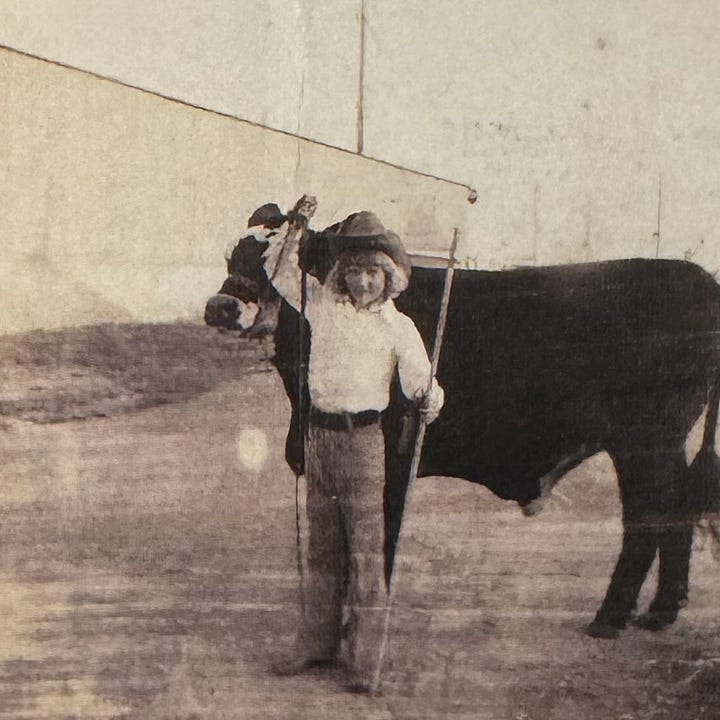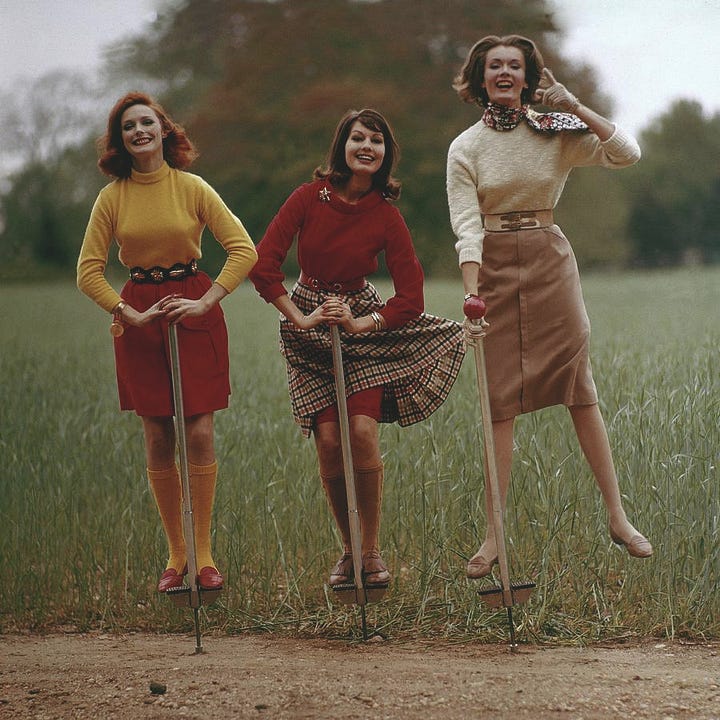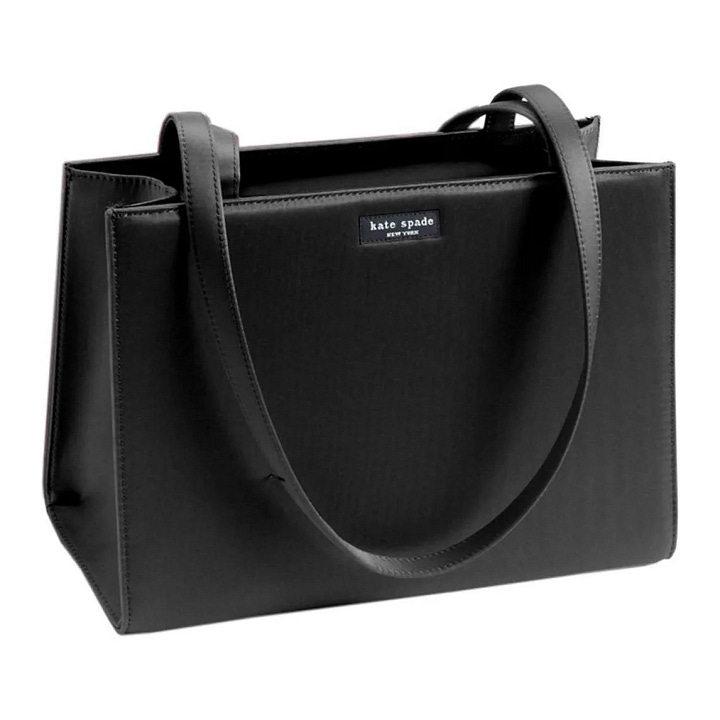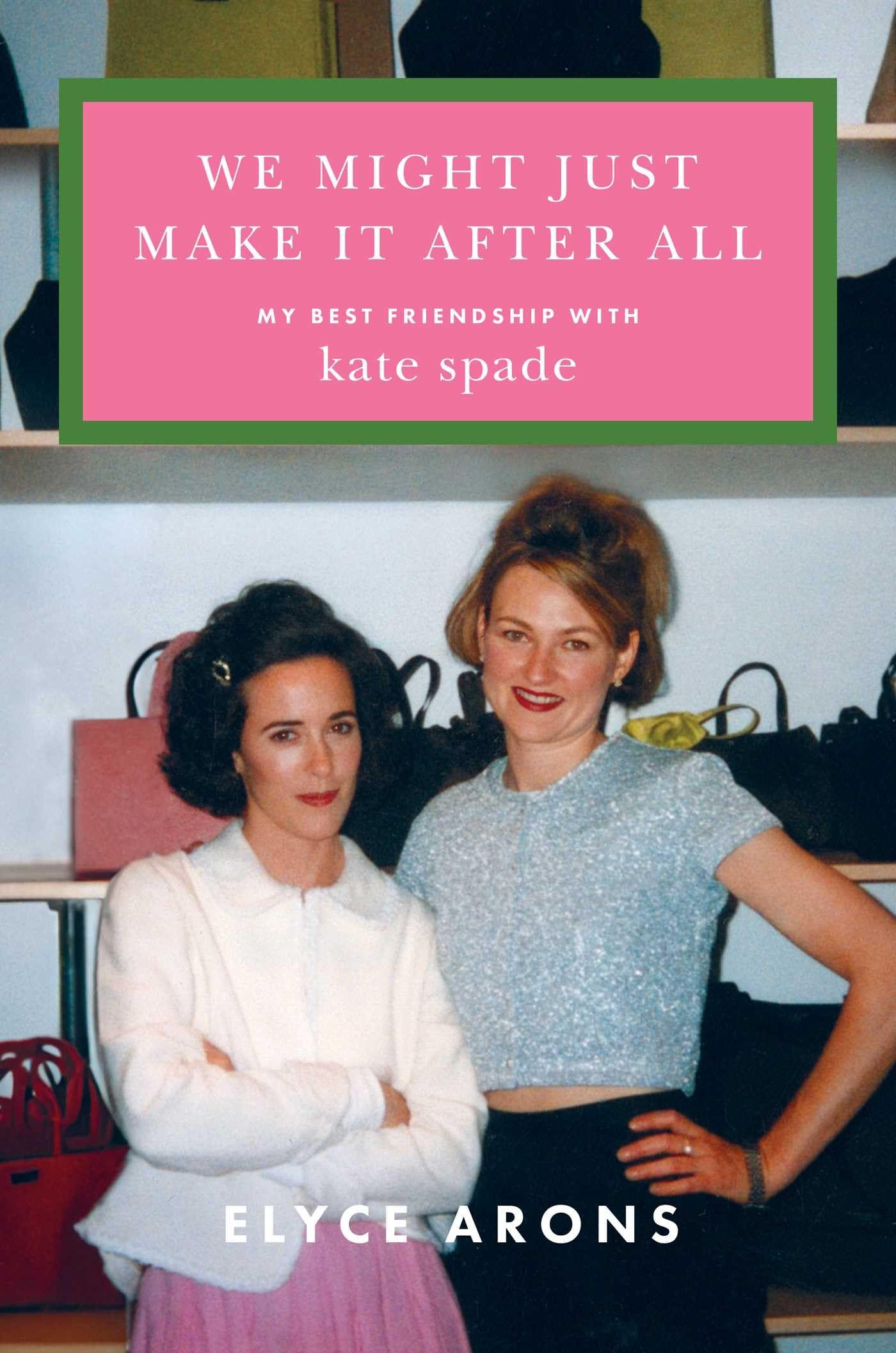The best friendship that made Kate Spade one of the most iconic brands of the ‘90s
Co-founder Elyce Arons joins me to chat about the magic behind those heavenly bags, loving and losing her best friend, and her new book, We Might Just Make It After All.
There’s a certain sentimentality tied to your first designer piece (pseudo or otherwise) that borders on the poetic. It’s like being granted access to a club of impossible glamour, one you’ve likely fantasized about for years from the pre-pubescent periphery. For so many women who came of age in the ’90s and early 2000s, the gateway drug of choice was a Kate Spade handbag: delightfully femme, (relatively) affordable, and stitched with a logo that declared its identity in the most demure of serifs.
For me, that initiation came not through a bag, but through scent: Spade’s very first fragrance in 2003. I remember reading about it in an issue of Vogue and begged my siblings to buy it for me as a birthday gift. It came in a beautifully curved glass bottle topped with a simple gold cap, and smelled like honeysuckle, gardenia and lily of the valley. To this day, I gravitate to those notes. One elegant spritz and I felt transformed—like Charlotte York, or Audrey Hepburn, or some other ultra-sophisticated brunette…Kate Spade herself.
Katherine Brosnahan, known to all as Katy, was born in Kansas City, Missouri. She met Elyce Arons during their freshman year at the University of Kansas in 1981, and their bond was instant. They were both Midwest girls, though their level of chic belied those humble beginnings. From college roommates to creative collaborators, the two moved to New York City and built the Kate Spade brand from the ground up, eventually launching it in 1993 with little more than a shared sense of taste and some sketches on a piece of paper. Along with their partners, Spade’s husband, Andy Spade, and Pamela Bell, they helped define a new era of American fashion.
At its height, the brand occupied a rarefied corner of the accessible fashion market, offering budding sophisticates a world of wit and whimsy. And it held that sunny position until 2018, when news broke that Spade had died by suicide.
After spending years trying to make sense of the loss and helming Frances Valentine, the duo’s subsequent brand, Arons put her memories into a new book, We Might Just Make It After All: My Best Friendship with Kate Spade. It’s a warm, funny, and deeply moving account of their early days—first meeting as teenagers in Kansas, moving to New York, building a brand that was and is still so beloved for so many—and of the enduring power of friendship, even in the face of unimaginable grief.
For the first Capsule 98 interview in this new format (yay!), Arons joins me to chat about the magic behind those heavenly bags, loving and losing her best friend, and carrying on her legacy.
You paint such an evocative picture of you and Katy’s early days together in college in the 1980s: The Waffle House at dawn, Charlie perfume, “Bette Davis Eyes” blasting in the background… What do you miss most about it?
I think it was that time of life when you're a young person and the whole world is before you and there's every possibility in the whole world. I was lucky enough to grow up during the ’70s, ’80s, and ’90s, and I just feel like it’s that time of life that you [miss]. There had been so much cultural change between the ’60s and ’70s and fashion changed along with it. Society changed in so many ways. It was a fascinating and really cool time to grow up.
If you were to close your eyes and bring back up a memory of growing up, where does your mind go first?
Probably watching my sisters getting ready. They had really, really short miniskirts and cutouts in their dresses with little Lucite circles in them. They were glamorous to me. My sister Holiday was nine years older, and my sister Shon, was eight years older. I was a kid watching them get ready. It was that fashion change from the ’60s into the ’70s (even in Kansas!) that was so exciting.
You mention that you and Katy were bonded by a love for vintage clothing, and those aesthetics have inspired you for a lifetime. What was your best thrift find ever and do you still have it?
There are so many pieces that have details and craftsmanship woven into them that are hard to find now, unless you're going to pay thousands of dollars for an item. I think my favourite, and that I still have and wear constantly, is a wool fisherman’s sweater. I bought it at least 25 years ago. It might have been 40 or 50 years old when I bought it. And I still wear it all the time. It's in perfect condition. Things were just made so well back then.
Your and Katy’s shared aesthetic has been so clearly defined for decades, even down to your hairdos — what would your advice be to others who are trying to develop their own sense of style? And how would you describe your own?
I think people, especially young women, should try a lot of things. Try trends out, see what you like, and see what works for you. Some trends might suit your style, and you can tweak them into your own personal look. I think we all go through that.
As far as Katy’s style and mine, it’s funny. She was very, I don’t want to say conservative, but Preppy was the thing when I got to college. I had just come back from New York with all these crazy, trendy things and thought I was really cool. But once I got to college, I kind of wanted to fit in more, so I bought my white shirts and changed my style a bit. We really influenced each other, showing each other different worlds and ways to do things. And with our love for vintage shopping, that direction deepened. We started finding beautiful pieces we could stick with and use in our wardrobes forever.
The era in which you founded Kate Spade feels impossible to replicate — it’s become the subject of so much fascination and nostalgia. Do you see it as a uniquely ‘90s success story?
I think it was totally unique to that era. There weren’t a lot of handbag companies, and designer brands making apparel weren’t necessarily going into handbags at the time. It was a unique idea that really resonated—functional, beautifully designed, stylish, and at an accessible price point, which made it special.
Since we launched that business, Katy’s story has meant so much to women starting businesses. They think, “Wow, she came from Kansas City, Missouri—people from the Midwest with no experience did this. Maybe I could too.” It’s been truly inspirational.
If we tried to do it today, I don’t know if it would work the same. There are so many products now, and media is so fragmented. Back then, it was fashion magazines and hard news, no social media, no constant noise. Celebrities didn’t play as big a role either, so starting a business like ours felt more possible in the ’90s. That era was unique.
What do you remember most about that time?
Starting a brand with my best friend and then the partners who came on. And how scrappy we were. We had no funding; it all came out of our own pockets. We took the subway or walked, never taxis. We made copies of our line sheets sparingly, only handing them out if we thought a store would actually buy, because even that cost money. I just remember being very frugal. And when you’re restricted like that, it forces you to be more creative in every way – and that’s a good thing.
Why do you think the bags were so successful and distinctive?
Because I think they were designer and luxury, but they were accessible to people. They were something that was unique in the market. Nobody was doing what we were doing at that time. The geometric shapes were really great. We had French seams on all of them. The material was new and different than what anybody had ever done before. And it really, to me, revolutionized the accessories business and the handbag business.
Do you still have all of the bags?
Yes, I have tubs and tubs and tubs of them, but I carry only Frances Valentine and wear only Frances too, because I’ve worn my Kate bags out. I’ve used them so much you wouldn’t want to carry one!
A big part of why I carry Frances Valentine is because I make what I really love. They’re functional, accessible, beautiful quality, and really well-designed. It’s the same aesthetic we started at Kate Spade.
Was there a moment when you truly felt, “Wow, we really made it after all?”
Probably one of the really striking moments was when Vogue came in to shoot us at the office. Because here we were, kids from the Midwest, and two years after we started, Vogue magazine was coming in to shoot the four of us for a feature article, and that was huge.
The photo [on the cover of the book] is from the day of that photo shoot. And that is Katy's wedding top I’m wearing. She said, “You have to look really good. And wear your hair up. And my wedding top!” It was very sweet.
Building a business with your best friend is the stuff of fantasies, and also cautionary tales — what was so unique about your bond that it allowed you to persevere through the challenges?
Well, you know, I think we bonded early on. We went from a cozy life at the University of Kansas to Arizona, with no other friends besides Katy's sister, so we had to make our own social circle. Katy was such a loyal person, and she knew I was. We respected each other. She made me laugh harder than anyone else, and I hope I did her.
When you find that person, it’s rare. Maybe it never happens for some people. But I think it’s once in a lifetime. Women’s relationships with their female friends are very special and different. We laughed with each other, we fought harder than anybody, but we always forgave each other.
What originally prompted you to write this book given how hard it has been to come to terms with her passing?
You know, it's taken me a long time to get here, just because it was very emotional. But people ask me about her and our relationship all the time. And I feel like this was a really good way to put all of those stories in one place and really talk about who she was as a person, and how gracious and empathetic and funny and lovely she was, rather than how she left us. So many people focus on that part of it, and I didn’t want to talk about that. I wanted to talk about how she lived and celebrate that - and our friendship.
How did you excavate so many precise memories so many years later?
I started taking notes on my phone. My husband really encouraged me. I kept saying, “I’m too busy with Frances Valentine, I can’t do it,” and he said, “If you don’t start, you’ll never do it. And you’ll start to forget things.”
So over time, I took notes on my phone – just one word would remind me of a story. I also talked to [our team] Andy Spade, Pamela Bell, and Mary Beth Schmidt. They reminded me of details, too. It took a lot of time - I’d go back through photos and calendars to remember where we were. Sometimes I had to Google events from the '90s, but info is surprisingly hard to find.
I kept all my calendars, those black Week-at-a-Glance ones, from back then. I marked everything: meetings, events, where Katy, Andy, Pamela were. I also kept all my spiral notebooks from meetings. Luckily I have a big basement! I still have all the tax returns and legal documents from the 13 years we owned Kate Spade. It’s been over 20 years now, and somehow I just couldn’t get rid of any of it. I always think, maybe there’s something in there I’ll need to remember.
Is there one moment from the ’90s that really stands out to you – an event, a show, or something you took part in that felt iconic, glamorous, or just unforgettable?
There are so many, but probably the biggest one was when Katy won the CFDA Award, and we walked the red carpet with all of the fashion celebrities. And here we were—you know, all the flashes are going off—and you keep thinking, "Oh, somebody’s going to walk up and say, you’re not supposed to be here," because you have that imposter syndrome. And I think a lot of people do.
But it was such a special night. It was, I think, the first time I ever had my makeup done professionally. And we actually spent a lot of money on dresses to wear that night. And Princess Di was there to honour [Harper’s Bazaar Editor in Chief] Liz Tilberis for her Lifetime Achievement Award. That night was really special.
Since Capsule 98 began with my own excavated time capsule from 1998, we’re asking you to share five “things,” whether a physical object, a feeling, or moment that would make it into your own personal time capsule.




My childhood cowboy hat: I had to wear that to show cattle and at horse shows. It was kind of a mustard-coloured one. At Western horse shows in Kansas, you always had to have a cowboy hat, boots, and Wrangler jeans – a show outfit. That was mine.
I know this sounds crazy, but my parents bought me a pogo stick when I was about 12. I was active, and my sister had left. I couldn’t drive yet, so I wore the springs out on that pogo stick because I used it so much.
A Kate Spade bag, probably one of our first ones—satiny nylon with webbing handles.
A Frances Valentine caftan, because that’s where our apparel started. We began with handbags and shoes, not apparel. After we lost [Katy], I pulled two of her favourite vintage pieces: a caftan she wore on every vacation and a sweater. We remade those as a tribute, and they sold out immediately, launching our apparel business, which is now 60 percent of what we do. The caftan was floral, light blue with oyster-coloured thread, flowers, and peacocks down the front, with bell-shaped sleeves. Vintage and original - it really launched our business, and we still sell lots of caftans today.
And lastly, my book, because it tells the whole story from basically 1981 onward.
We Might Just Make it After All is available through Amazon, and everywhere books are sold.









What great memories! Dreams come true!
Such a terrific interview — thank you — juicy questions that prompted detailed answers! I listened to the audiobook and enjoyed the flashbacks into a lost NYC. I (like so many) saved up for my first Kate Spade handbag — a boxy tote with short webbed handles — in 1996. Paying in Canadian dollars was painful! But I loved it to bits.